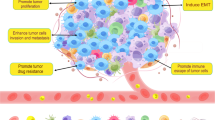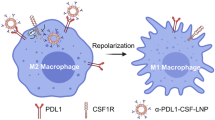Abstract
Purpose. Investigation of the ability of doxorubicin-loaded nanoparticles (NP/Dox) to overcome multidrug resistance (MDR) when they have first been taken up by macrophages.
Methods. The growth inhibition of P388 sensitive (P388) and resistant (P388/ADR) tumor cells was evaluated in a coculture system consisting of wells with two compartments. The tumor cells were seeded into the lower compartment, the macrophages were introduced into the upper part in which the drug preparations were also added.
Results. Doxorubicin exerted lower cytotoxicity on tumor cells in coculture compared with direct contact. In P388/ADR, NP/Dox cytotoxicity was far higher than that of free doxorubicin (Dox). Three different formulations of cyclosporin A (either free (CyA), loaded to nanoparticles (NP/CyA) or in a combined formulation with doxorubicin (NP/Dox-CyA)), were added to modulate doxorubicin efficacy. The addition of cyclosporin A to Dox increased drug cytotoxicity. Both CyA added to NP/Dox and NP/Dox-CyA were able to bypass drug resistance.
Conclusions. Despite the barrier role of macrophages, NP/Dox remained far more cytotoxic than Dox against P388/ADR. Both NP/ Dox + CyA and NP/Dox-CyA allowed to overcome MDR, but the last one should present greater advantagein vivo by confining both drugs in the same compartment, hence reducing the adverse effects.
Similar content being viewed by others
REFERENCES
N. Chiannilkulchai, Z. Driouich, J. P. Benoit, A. L. Parodi, and P. Couvreur. Doxorubicin-loaded nanoparticles: increased efficiency in murine hepatic metastases. Sel. Cancer. Ther. 5:1–11 (1989).
K. Yachi, N. Suzuki, N. Tanaka, K. Okada, I. Mitsui, Y. Kawato, Y. Komagata, K. Komiyama, and H. Kikuchi. The effect of adriamycin against a liver metastatic model by encapsulation in liposomes. Biopharm. Drug Dispos. 17:699–715 (1996).
C. Cuvier, L. Roblot-Treupel, J. M. Millot, G. Lizard, S. Chevillard, M. Manfait, P. Couvreur, and M. F. Poupon. Doxorubicin-loaded nanospheres bypass tumor cell multidrug resistance. Biochem. Pharmacol. 44:509–517 (1992).
S. Bennis, C. Chapey, P. Couvreur, and J. Robert Enhanced cytotoxicity of doxorubicin encapsulated in polyisohexylcyanoacrylate nanospheres against multidrug-resistant tumor cells in culture. Eur. J. Cancer 30A:106–111 (1993).
A. Colin de Verdière, C. Dubernet, F. Nemati, E. Soma, M. Appel, J. Ferté, S. Bernard, F. Puisieux, and P. Couvreur. Reversion of multidrug resistance with polyalkylcyanoacrylate nanoparticles: towards a mechanism of action. Br J Cancer 76:198–205 (1997).
J. A. Kellen. The reversal of multidrug resistance in cancer. Anticancer Res. 13:959–961 (1993).
G. Toffoli, G. Corona, R. Sorio, A. Bertola, and M. Boiocchi. Reversal activity of cyclosporin A and its metabolites M1 M17 and M21 in multidrug-resistant cells. Int. J. Cancer 71:900–906 (1997).
R. C. Maia, M. K. Carrico, C. E. Klumb, H. Noronha, A. M. Coelho, F. C. Vaasconcelos, and V. M. Ruimanek. Clinical approach to circumvention of multidrug resistance in refractory leukemic patients: association of cyclosporin A with etoposide. J. Exp. Clin. Cancer Res. 16:419–424 (1997).
M. L. Den Boer, R. Pietres, K. M. Kazemier, G. E. Janka-Schaub, G. Henze, and A. J. Veerman. The modulating effect of PSC833, cyclosporin A, verapamil and genistein on in vitro cytotoxicity and intracellular content of daunorubicin in childhood acute lymphoblastic leukemia. Leukemia 12:912–920 (1998).
N. Chiannilkulchai, N. Ammoury, B. Caillou, J. Ph. Devissaguet, and P. Couvreur. Hepatic tissue distribution of doxorubicin-loaded nanoparticles after i.v. administration in reticulosarcoma M5076 metastasis-bearing mice. Cancer Chemoter. Pharmacol. 26:122–126 (1990).
T. Mosmann. Rapid colorimetric assay for cellular growth and survival: application to proliferation and cytotoxicity assays. J. Immunol. Methods 65:55–63 (1983).
F. Martin, A. Caignard, O. Olsson, J. F. Jeannin, and A. Leclerc. Tumoricidal effect of macrophages exposed to adriamycin in vivo or in vitro. Cancer Res. 42:3851–3857 (1982).
Y. Adachi, S. Arii, N. Funaki, H. Higashitsuji, S. Fujita, M. Furutani, M. Mise, W. Zhang, and T. Tobe. Tumoricidal activity of Küpffer cells augmented by anticancer drugs. Life Sci. 51:177–183 (1992).
B. Ryffel, M. J. Mihatsch, and G. L. Fisher. Immunosuppression and cancer: the ciclosporin case. Drug Chem. Toxicol. 15:95–115 (1992).
R. Fernandez-Urrusuno, E. Fattal, J. M. Rodrigues Jr., J. Féger, P. Bedossa, and P. Couvreur. Effect of polymeric nanoparticle administration on the clearance activity of the mononuclear phagocyte system in mice. J. Biomed. Mat. Res. 31:401–408 (1996).
G. Storm, P. A. Steerenberg, F. Emmen, M. van Borssum Waalkes, and D. J. A. Crommelin. Release of doxorubicin from peritoneal macrophages exposed in vivo to doxorubicin-containing liposomes. Biochim. Biophys. Acta 965:136–145 (1988).
J. Andersson, S. Nagy, C. G. Groth, and U. Andersson. Effects of FK506 and cyclosporin A on cytokine production studied in vitro at a single-cell level. Immunology 75:136–142 (1992).
H. Hölschermann, F. Dürfeld, U. Maus, A. Bierhaus, K. Heidinger, J. Lohmeyer, P. P. Nawroth, H. Tillmanns, and W. Haberbosch. Cyclosporine A inhibits tissue factor expression in monocytes/macrophages. Blood 88:3837–3845 (1996).
M. Conde, J. Andrade, F. J. Bedoya, C. Santa Maria, and F. Sobrino. Inhibitory effect of cyclosporin A and FK506 on nitric oxide production by cultured macrophages. Evidence of a direct effect on nitric oxide synthase activity. Immunology 84:476–481 (1995).
Y. Hattori and N. Nakanishi. Effects of cyclosporin A and FK506 on nitric oxide and tetrahydrobiopterin synthesis in bacterial lipopolysaccharide-treated J774 macrophages. Cell Immunol. 165:7–11 (1995).
T. Tojimbara, L. E. Bermudez, H. Egawa, M. Hayashi, S. K. So, and C. O. Esquivel. Cyclosporine and tacrolimus both suppress activation of Küpffer cells in vitro. Transplant Proc. 28:1381–1382 (1996).
C. E. Soma, C. Dubernet, and P. Couvreur. Investigation of macrophage role in the cytotoxicity of doxorubicin and doxorubicin-loaded nanoparticles on M5076 cells in vitro, Proc. 2nd World Meeting APGI/APV, Paris, 25–28 May, p. 635 (1998).
Author information
Authors and Affiliations
Corresponding author
Rights and permissions
About this article
Cite this article
Soma, C.E., Dubernet, C., Barratt, G. et al. Ability of Doxorubicin-Loaded Nanoparticles to Overcome Multidrug Resistance of Tumor Cells After Their Capture by Macrophages. Pharm Res 16, 1710–1716 (1999). https://doi.org/10.1023/A:1018902031370
Issue Date:
DOI: https://doi.org/10.1023/A:1018902031370




